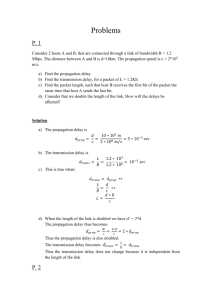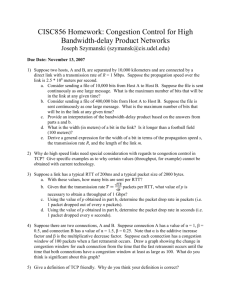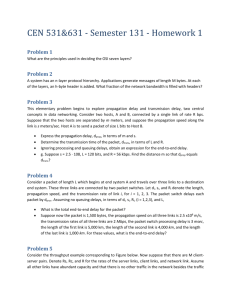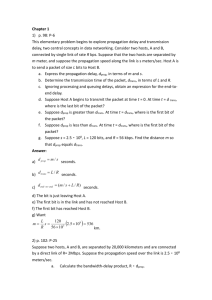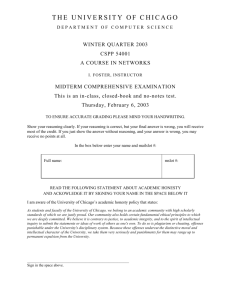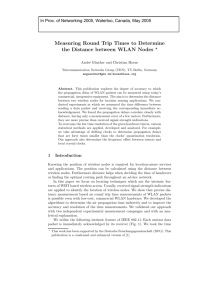WordDoc - UCSB Computer Science
advertisement
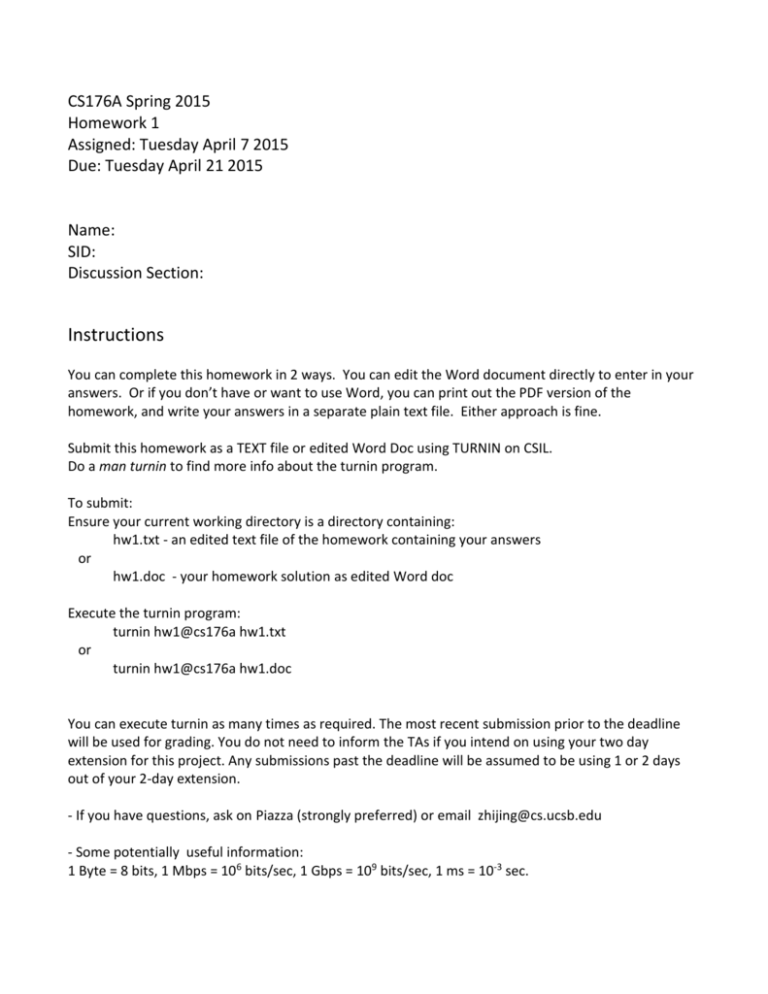
CS176A Spring 2015 Homework 1 Assigned: Tuesday April 7 2015 Due: Tuesday April 21 2015 Name: SID: Discussion Section: Instructions You can complete this homework in 2 ways. You can edit the Word document directly to enter in your answers. Or if you don’t have or want to use Word, you can print out the PDF version of the homework, and write your answers in a separate plain text file. Either approach is fine. Submit this homework as a TEXT file or edited Word Doc using TURNIN on CSIL. Do a man turnin to find more info about the turnin program. To submit: Ensure your current working directory is a directory containing: hw1.txt - an edited text file of the homework containing your answers or hw1.doc - your homework solution as edited Word doc Execute the turnin program: turnin hw1@cs176a hw1.txt or turnin hw1@cs176a hw1.doc You can execute turnin as many times as required. The most recent submission prior to the deadline will be used for grading. You do not need to inform the TAs if you intend on using your two day extension for this project. Any submissions past the deadline will be assumed to be using 1 or 2 days out of your 2-day extension. - If you have questions, ask on Piazza (strongly preferred) or email zhijing@cs.ucsb.edu - Some potentially useful information: 1 Byte = 8 bits, 1 Mbps = 106 bits/sec, 1 Gbps = 109 bits/sec, 1 ms = 10-3 sec. 1. (20 points) Miscellaneous Short Questions (a) (4 points) Consider a single link with bandwidth B and propagation delay (i.e., latency) L. It takes 1ms for an entire 500 byte packet to arrive at other end of the link (that is, it takes 1ms from the time the first bit starts being transmitted until the last bit arrives at the other end of the link). It takes 2ms for an entire 1500 byte packet to arrive at the other end of the link. (i) What is the bandwidth B of the link? (in Mbps) (ii) What is the propagation delay L of the link? (in ms) (b) (4 points) Which of the following reflects the Internet’s “best effort” design philosophy? (Select all that apply.) 1. Packets can be dropped 2. Switches have finite buffer capacity 3. Reuse of existing telephone lines 4. Organizing functionality in layers (c) (4 points) Which of the following design choices helped the Internet to scale? (Select all that apply.) 1. Reuse of existing telephone lines 2. Setting a minimum threshold of acceptable end-to-end packet delay 3. Settling on IP as the common protocol for interconnection 4. Statistical multiplexing at the granularity of individual packets (d) (4 points) Reverse engineering links characteristics: Consider a link with band-width B and latency (i.e. one way propagation delay) L, with hosts 1 and 2 attached to opposite ends of the link. Starting at time t=0, Host 1 sends two data packets (back-to-back) to Host 2, which ACKs them immediately (requiring no processing time). The ACKs arrive at times T1 and T2. The data packets are of size P and the ACKs are of size A. (You may assume A < P ). Solve for link bandwidth B in terms of the arrival times T1 and T2, and the packet sizes P and A. The expression for B should not contain L on the right-hand- side. (e) (2 points) Suppose you would like to urgently deliver 300 TB of data from Boston to Los Angeles. You have available a 1 Gbps dedicated link for data transfer. Which of the following approaches would you prefer to transmit the data? A. The 1 Gbps link B. FedEx overnight delivery on a hard drive (f) (2 points) Indicate which of the following are true: 1. Packet switching is more efficient than circuit switching because it uses statistical multiplexing at a finer granularity 2. The Internet uses layering to achieve high performance 3. The Internet’s use of layering encourages innovation in link technologies 4. Transmission time dominates propagation time when transferring a 1GB file over a 1Gbps satellite link that has a propagation delay of 10 seconds 2. (12 points) Bottleneck Links Consider Figure 1 below. Assume that we know the bottleneck link along the path from A to B is the first link with RS bits/sec. Suppose we send a pair of packets back to back from A to B, and there is no other traffic on this path. Assume each packet of size L bits, and both links have the same propagation delay dprop . Figure 1: Throughput for a file transfer from server to client (a) (4 points) Consider Figure 1(a). What is the packet inter-arrival time at the destination? That is, how much time elapses from when the last bit of the first packet arrives until the last bit of the second packet arrives? (b) (2 points) Again consider Figure 1(a). Now assume that the second link is the bottleneck link (i.e., RC < RS ). Is it possible that the second packet queues at the input queue of the second link? Explain. (c) (2 points) Once more consider Figure 1(a). Now, suppose that A sends the second packet T seconds after sending the first packet. How large must T be to ensure no queuing before the second link? Explain. (d) (4 points) Consider Figure 1(b). Suppose that there are M paths between A and B. No two paths share any link. Path k (k = 1, . . . , M) consists of N links with transmission rates (i) If A can only use one path to send data to B, what is the maximum throughput that it can achieve? (ii) If A can use all M paths to send data, what is the maximum throughput that it can achieve? 3. (10 points) Link Properties Suppose two hosts, A and B, are separated by 20,000 kilometers and are connected by a direct link of R = 2 Mbps. Suppose the propagation speed over the link is 2.5x108 meters/sec. (a) (2 points) Calculate the bandwidth-delay product, R x dprop . (b) (2 points) Consider sending a file of 800,000 bits from Host A to Host B. Suppose the file is sent continuously as one large message. What is the maximum number of bits that will be in the link at any given time? (c) (3 points) Visualize the link as a pipe filled with a sequence of bits. What is the width (in meters) of a bit in the link, i.e., what fraction of the link corresponds to one bit? (d) (3 points) Derive a general expression for the width of a bit in terms of the propagation speed s, the transmission rate R, and the length of the link m. 4. (10 points) Fun! The ping program determines the round-trip-time (RTT) to any host in the Internet. Using a computer on campus (either your device connected to UCSBWireless or an instructional machine), ping the following hosts five times each to calculate an “average RTT”: - stanford.edu (Palo Alto, CA) - cmu.edu (Pittsburgh, PA) - washington.edu (Seattle, WA) - cam.ac.uk (Cambridge, UK) - monash.edu.au (Melbourne, AUS) - iitd.ac.in (Delhi, India) - nus.edu.sg (Singapore) - uwaterloo.ca (Waterloo, Canada) For each of these cities find the physical distance from Santa Barbara (You can look these up here: http://www.geobytes.com/citydistancetool.htm), and then compute the estimated time T for a packet to reach that location. (a) (7 points) Plot a graph where the x axis represents distance to each city, and the y axis represents the ratio between the RTT as measured by the ping program and the shortest possible time 2T to reach that city and return. You may disregard transmission delays, as ping packets are quite small. (b) (3 points) What is the ideal ratio? Did you achieve it? Does the ratio increase, decrease, or stay the same as geographical distance increases? Why might this be the case?
